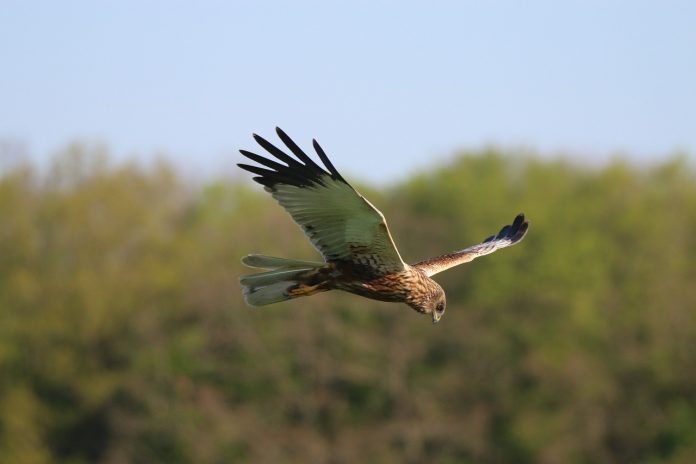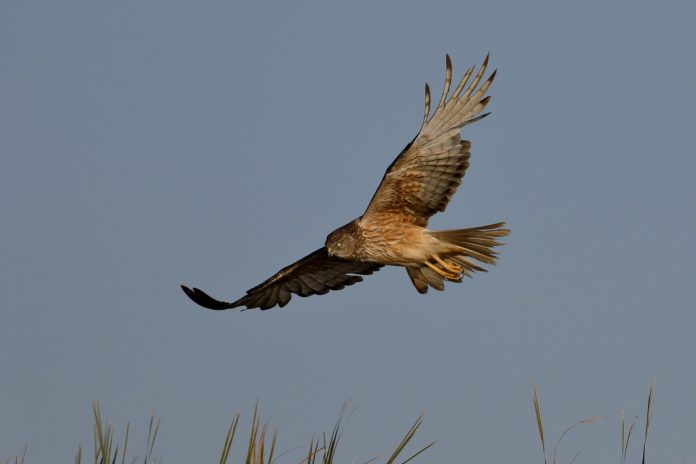TRUE TO ITS AME, the Swamp Harrier (Circus approximans) is habitually seen singly or in pairs coursing low over the pasture of an open marsh, reed bed, or rank field near water. It glides along on long upswept wings, flapping only sporadically.
Surprise is a crucial element of its hunting, as it abruptly looms over its prey: water birds of all kinds, as well as petite mammals, frogs, reptiles, and large insects. Like all harriers, it has an unfinished owl-like facial disc which improves its hearing, and long lanky talons for plucking its victims from thick growth while it stands clear.
Swamp Harrier rest, roost, and feed on the ground, from time to time using a low stump, and often building platforms of weed in brakes of reeds for these purposes. In Australia, Swamp Harriers are partly nomadic and migratory, southern birds shifting north in winter and back to breed in summer.
As breeding approaches they display on the wing at a great height, maneuvering about, side-slipping and plummeting down, and rising up on half-closed wings while whistling loudly. Several birds may display at the same time, and each ends its flight with dives over its own territory.
Both sexes participate to build the new nests each year in traditional territories, but only the female incubates, broods, and feeds the young. The male does all the hunting while the female is sitting; he calls her off the nest to give her food in midair in a talon-to-talon pass near the nest.
This process continues until the young are about a week old, from which time both parents hunt and drop food at the nest. Most young fledge although the elder will kill and eat the younger if food is short; eggs are laid at several day intervals and hatch in that order.
By reaching the fourth week, the young are fully feathered and they fledge in another two, returning to the nest to rest and feed in the first week or two after taking their first flight. Adult Swamp Harriers resemble immature Spotted Harriers but can usually be distinguished by their plainer grey tails. All Swamp Harriers show a whitish band on the lower rump in flight.
It is also known as Marsh Harrier, Gould’s Harrier, Australasian marsh harrier, Australasian harrier, and Swamp Hawk. The size of a Swamp Harrier is about 510-590 mm in length. MALE: Mottled and streaked dark brown above, grading to plainer grey on the tail and mid-grey dully barred dusky on flight feathers; a conspicuous off-white band across upper tail coverts. Underparts buff streaked are dark brown, grading to plainer off-white on the belly, flanks, and crissum.
The eyes are yellow, while the bill is dusky; cere dull lemon. Feet are yellow, and claws are black. The female bird is larger than the male. Bit browner, with heavier streaking extending over belly, flanks, and crissum. Whereas, the immature bird is dusky brown above, dark russet-brown and unstreaked below; pale area on the underwing.
The eyes are brown. Downy young are white-gray; eyes are dark; bill and cere as an adult. Swamp Harrier is generally a silent bird. However, the food calls are during breeding a high-pitched whistle, pseee-uh. In courtship, a short, loud, whistled keee-a or keee-o. The nesting and breeding season is September-January. They build a nest around a 600 mm diameter platform of light sticks, reeds, and weeds, lined with grasses; hidden in brakes of reeds or rushes over water, less often on the ground among bushes or grain crops.
Normally they are laid three to six eggs, but often four; dull plain white with blue tinge; rounded-oval, about 50 x 38 mm. The incubation period is about 33-35 days, for females. The young bird fledges in about 43-46 days. Swamp Harrier has flooded reed beds and wet pastures around coastal Australia, Tasmania, and inland river systems.
Swamp Harrier is a nomadic and migratory, Tasmanian bird wintering on the mainland. Also found in New Zealand, southern New Guinea, and islands in the southwestern Pacific. There are two races; one, large, is in Australia.
Related Reading – Montagu’s Harrier – Graceful Flight is Characterized by Powerful and Elegant Wingbeats









